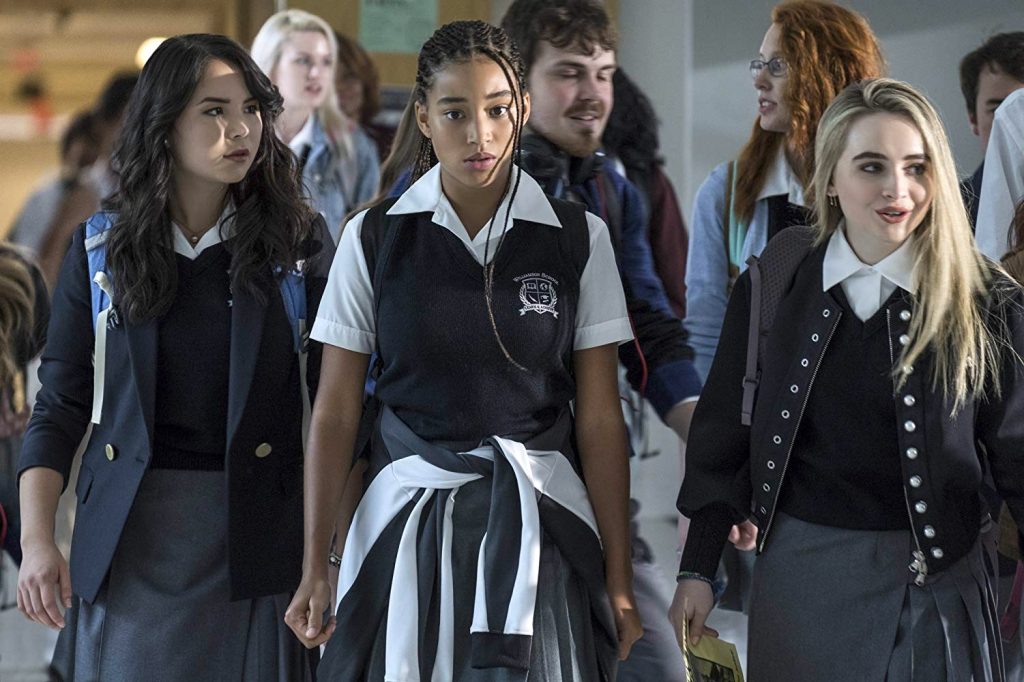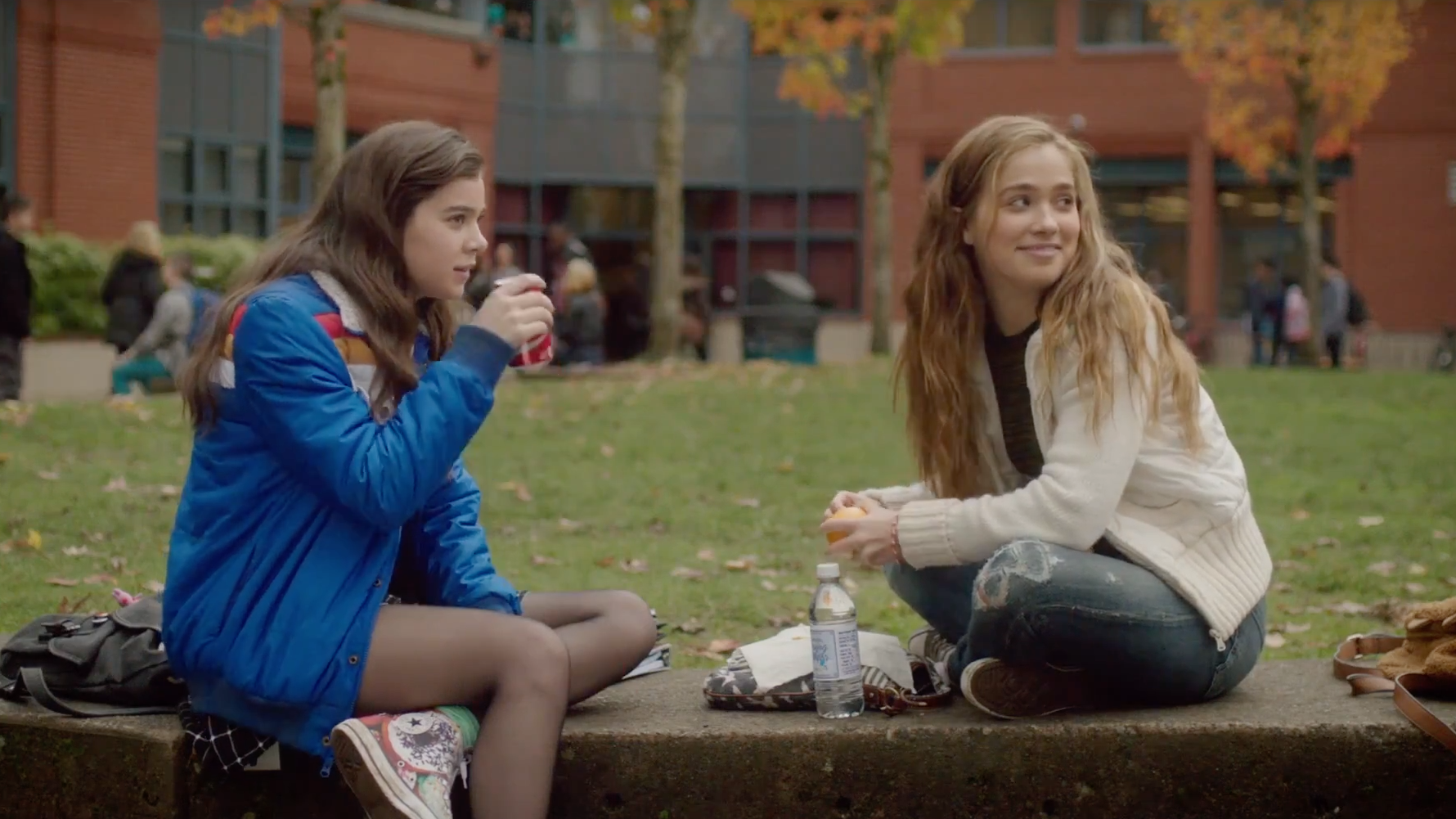- What Makes High School Movies Work? (Part 1)
- What Makes High School Movies Work? (Part 2)
Archetypes
Parents (good and bad), teachers (good and bad), friends, teammates, and classmates (good and bad), and siblings all form the basis of an archetypal character set.
In The Edge of Seventeen:
Nadine’s mother: a bit unraveled and trying to cope with her own life as well as her two children. Nadine’s father is dead and that’s a deep hole in her life.
Nadine’s brother: Darian is tall, athletic, handsome, and popular. Most things Nadine isn’t which has created this huge gap between them.
Mr. Bruner: An acerbic but understanding teacher who Nadine feels comfortable confessing to. It’s my contention that he was created in this sarcastic mold to deliberately reflect back Nadine’s melodrama, and also to act as a sort of oracle, the wise teacher living above it all so Nadine could talk to him without much judgment from him.
Krista: Friend, friend, friend… betrayer. Because Krista and Darian hook up (yes in the sexual sense) Nadine feels isolated and strikes out at both. This situation is used as a way to transition Nadine to a more adult attitude about the way forward in life. Life is change. Nadine must accept that.
Nick (Alexander Calvert): The unattainable hottie who stands for values that the main character thinks they want but are really false given who they really are. This causes a learnable moment in the character’s storyline as the inevitable rejection occurs.
The rival, Shannon (Nesta Cooper): films like Mean Girls, Heathers, and of course Edge Of Seventeen have a cliquey group led by a particularly nasty rival who is meant to embarrass and cause grief for the main character. No strength or growth without conflict is the reason.
Erwin: The lovable boy friend who becomes a boyfriend. This particular trope is used extensively in many high school movies and TV series. Again, this is a growth scenario so the character can see with clearer eyes what is really important as they transition to adulthood.
Tone
One of the joys of high school movies and TV is the ridiculously vast tonal motifs available. Everything from the fun and silly Superbad or Project, to the somber Palo Alto and challenging, powerful “he Hate U Give (which was criminally under-represented at the 2018 Academy Awards).

Key cast in The Hate U Give. Photo courtesy of 20th Century Films
Edge Of Seventeen splits the difference as a serio-comic dramedy.
An example is this hard-to-watch, but funny moment where Mr. Bruner reads the text Nadine accidentally sent to Nick, her crush.
Nadine storms into Mr. Bruner’ classroom.
Without explanation, she hands Bruner her phone.
BRUNER
(reading)
“You’re complicated and simple. And I just feel this
connection between us. I feel like I already know you.”
(beat)
This is kind of sweet. I think you’re overreacting.
“I just wanna be with you. I wanna give you… head.
I want you to put your…
We can do it in the Petland stockroom.”
Bruner frowns, thinking.
NADINE
Say something. Oh, my god, say something, please.
Help me.
He thinks. Finally –
BRUNER
You need to watch out for run-on sentences.
NADINE
(freaking out)
But can’t you just do something? Can’t you…
can’t you just do something?
You gotta be able to do something.
(even more frantic)
If you get his address and you confiscate his phone, great.
Get his address. You give it to me. I’m gonna go there.
And I’m gonna, um…
She’s losing it.
Later, Nadine and the object of the email (Nick) go out on a date.
It begins to get amorous. Too amorous for Nadine.
Nick parks the car. Nadine smiles as Nick looks over at her.
NADINE
I can’t believe this is happening. There’s so much that I’ve
wanted to tell you and ask you, and I just can’t believe this…
He moves toward her, lowers the seat until it reclines.
NADINE
Um… Oh, wow. It just keeps going back, doesn’t it?
Nick’s hands begin to roam over Nadine’s body. The panic she now feels is clearly reflected on her face as she realizes that Nick is taking her email literally and is wanting to have sex with her.
NADINE
Yeah… I don’t know if I should…
He reaches to remove her panties. She goes into full panic mode, pushes him away.
NADINE
Get off! Get off! Off!
A confused Nick rolls off her.
NICK
Okay. What the hell?
Earlier Nadine had teased her buddy Erwin about hooking up and it insulted and hurt him. She still doesn’t get that actions have consequences, especially when it comes to sexual matters. With Nick she is shown that again. All part of her growth and illustrating some of the more serious themes here. There was real fear that Nick wouldn’t stop his advances.
Of course, as stated, movies like The Hate U Give have a completely different tonal palette as friends are killed and families are threatened. The main character, Starr (Amandia Stenberg ) lives in two worlds: her challenging home neighborhood and the upper-middle class private school she attends. She even calls herself Starr One and Starr Two to differentiate the different people she is when at each location.
Her lesson is from a Tupac Shakur quote and forms both the title and theme of the movie.
The range in high school movies is truly immense. 13: The Musical is sweet and uplifting. 13 explores a young girl’s train wreck of a life as she speaks to herself via TikTok videos. Kids is shocking and bleak, Me and Earl and the Dying Girl is painful, Bottoms strike a goofy blow for the LGBTQ+ community. Project X is just insane. Elephant based in the Columbine shootings is plain scary.
The gamut is huge and the range almost unlimited for anyone wanting to write a high school film or television series.
Techniques/ Motifs
Some would call these cliches. And done badly, they are. They are also strong motifs/tropes, and techniques that define a genre and can be elevated beyond the cliches they’ve become.
- The Outsider – typically the main character. It’s rare that any popular kid is used as a main character because it’s not as dramatic a catharsis as the person who is alienated from their peers.
- Sex – losing one’s virginity seems to pop up a lot even in today’s woke world. If the quest comes with insight it can be very illuminating. In 13: The Musical with its underage protagonists it’s a first kiss that becomes the goal.
- The Crush – the unattainable love interest is always a good motor to keep the story running strong. It offers many opportunities for funny/serious moments and I doubt any of us hasn’t been on one end or the other of this.
- “Slut Shaming” – male or female. This goes hand in hand with bullying. Easy A is probably one of the best examples of this, but Mean Girls also pushes this really hard to good effect.
- Social climbing – you can see this explored in Heathers and The Edge of Seventeen as well as Mean Girls. Social climbing is a very strong motif in almost all high school movies.
- True Friends – Book Smart shows the value of real friends, those who have your back in any circumstance. Most times this is connected to social climbing where the central character or their old friend goes rogue with the ‘cool kids’.
- The Lunch Table – how many scenes have we seen where the cafeteria is segregated by groups (Geeks, Nerds, Jocks, Plastics, Cheerleaders, etc.) and this segregation serves as a way to show social movement when a character is invited to the ‘cool’ table and abandons their normal table of friends.
- Bullying – Glee has slushies, others have the evil Jocks/ Cheerleaders/ Gangsters who rule the school. Even in today’s woke world, this motif still resonates strongly. “Dope” has shoe-stealing gangsters who don’t steal lunch money, they steal Jordans.
- Clueless Parents – well, duh. Every generation of stories, and I do mean every gen uses this motif because it’s so reliably relatable. Who hasn’t thought their parents out of touch and unreasonable? Even if the characters truly love their parents, they rail against the restrictions placed on them, and that’s usually the job of mom and dad.
- A side slice of this is the missing parent through abandonment or divorce. This creates a backstory that has real impact.
- Graduation – many stories use this as a plot engine to tie the other stories together. That diploma is an outsized achievement and many times of super importance.
- Tutoring – nothing gets two disparate people together like tutoring where the smart kid helps the underachiever to pass the next test. Words On A Bathroom Wall utilizes this to good effect.
- Social Media – not much moves us in today’s world like social media. Texting, TikTok(ing), SnapChat, inadvertent Send Alls are a part of everyone’s life and most especially youth which has embraced these mediums like extension of their bodies.
In Conclusion
Bob Dylan has a lyric, “Oh, but I was so much older then, I’m much younger than that now.” High school movies succeed and thrive across many generations because of the seriousness of that time of life. Sure, getting older is hard as we matriculate to college and adulthood, but there’s nothing quite as difficult as high school. Writing about it brings insight and the persistent themes of growing into our skins make that script universal.

